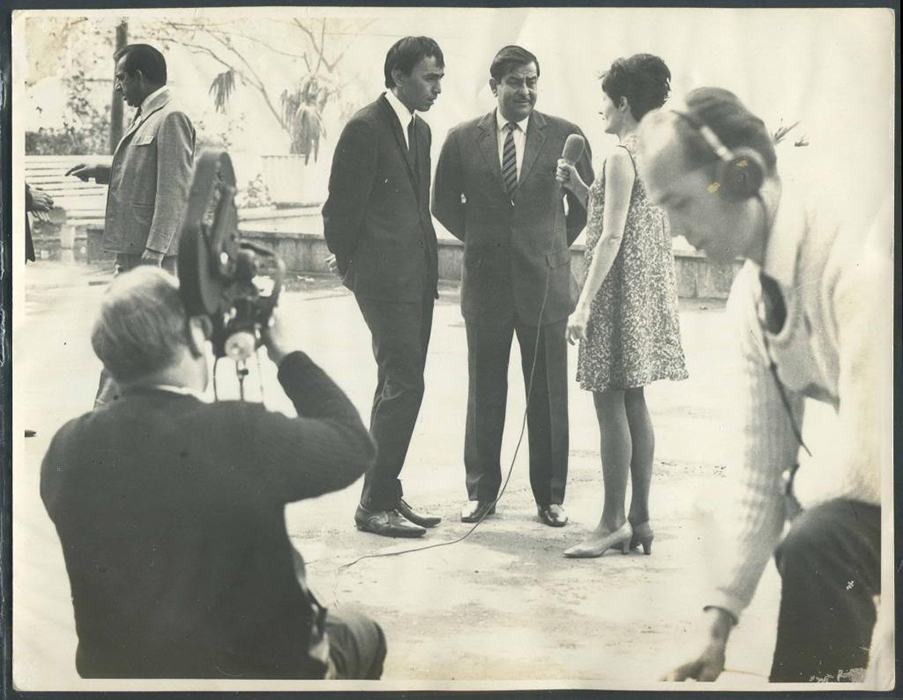The escapist fantasies of Bollywood were just the balm a war-weary Soviet Union needed, says Debatri Sengupta.
Elmar Rajsur is a minor celebrity in his country, albeit a slightly unorthodox one. He sings Bollywood songs for a living. Rajsur is Russian, and if his profession isn’t amusing enough, his name is, in fact, an amalgam of Raj Kapoor and Suresh Wadhwan.
The ‘golden age’ of Bollywood was savoured not just by Indians, but found an overwhelming reception in the largest nation in the world—the Soviet Union. The Russian audience embraced the roguish charm of Raj Kapoor, serenaded heroines atop hills with Rishi Kapoor, shared Mithun Chakraborty’s abundant zeal with an almost unparalleled passion.
When the USSR came into existence in December 1922, cinema, much like everything else, became nationalised. Cinema became a tool for propaganda, and the regimental screening of Soviet cinema meant that hardly a handful of indigenous movies could achieve perestroika, and even these had to uphold the ‘social realism’ of Soviet politics. For a generation reeling from the aftermath of a revolution and a civil war, for a population that was largely illiterate but instinctively sensitive, entertainment was scanty and when their cinema also became resonant of the cold, listless life of the times, they rejected it whole-heartedly.
Cinema became a tool for propaganda, and the regimental screening of Soviet cinema meant that hardly a handful of indigenous movies could achieve perestroika, and even these had to uphold the ‘social realism’ of Soviet politics.
The Soviet government, however, allowed the screening of foreign films. The reason behind this unexpected leniency was possibly the fact that their potential to either ‘agitate’ or ‘propagate’ was considered considerably low by virtue of their distant culture. But when Raj Kapoor’s Awara released in 1954, in a festival of Indian films, it was received by the Russian audience with a gusto that was on par with, or maybe even more than, their Indian counterparts.
This was followed by Shree 420, Mera Naam Joker, Seeta aur Geeta, Bobby, Disco Dancer, all of which roped in millions of viewers. Although there were fanatic admirers of Indian heroes and heroines, Raj Kapoor remain the most loved and admired of all. His Chaplinesque image as a picaresque protagonist lived on as an epitome of the quintessential hero, one who despite being a hero was a common man, one who survived all the odds and always emerged on the better side of the moral spectrum. In fact, what allured most was the very lack of a moral spectrum, for there was a distinct segregation of good from the bad. What may be seen as a simplification of human emotions and realities can also be seen as a metaphor that the war-struck Russians desperately needed as an anchor to formulate renewed perspectives.
The Russian love affair with Bollywood cannot be read without its socio-political reasons, and at the cost of sounding sentimental, it is quite pragmatically conjectured that this unexpected affinity for cinema in an alien language from a distant land and culture was a kind of compensation for the squalor of their own lives.
What may be seen as a simplification of human emotions and realities can also be seen as a metaphor that the war-struck Russians desperately needed as an anchor to formulate renewed perspectives.
“The aesthetics of Indian films is simple and clear,” writes Russian journalist Alexander Lipkov. “The landscape has a festive charm with blossoms, waterfalls, exotic mountains, rock formations, secret shrines—everything that is remote from the reality familiar to the viewer. ‘Essentially beauty can be seen only in Indian films. Life is boring, grey and sordid but in Indian films (incomparable with any other) there is so much beauty, music and love.’ I cite this from a letter from one of the viewers, impatient with Soviet films which merely show the same as what happens at home and at work. ‘You see it and your heart rejoices. Everything is beautiful; there is so much beauty that you do not want to leave the cinema, especially when you think of what awaits you outside.’ This is cited from another letter.”
Simplicity, therefore, was not shallow. Simplicity was a necessity. Beauty was hope. The simplification of complex realities like love, poverty and so on through melodrama, a certain unadulterated romanticism, a premature black-and-white conception of good and bad was thus a desperate requisite to reestablish faith and belief in a nation scarred by continuous loss.
There is, however, no one discourse in any reality. So, while a large population of both the Indian and the Russian audience were lapping up commercial churn outs, there was a parallel movement in Indian cinema at the very same time. Parallel cinema—or ‘art’ films, as they were called—aimed at portraying the socio-political realities of the time, the very intricacies of human life, the many shades of emotion sans the melodrama and song-and-dance embellishments.
“Benegal was at least somehow seen,” Lipkov recollects, “but the audience walked out during the Ray films. (I will never forget how the halls emptied during the festival screening of Teen Kanya and they simply fled from Sen.)”
Needless to say, Indian parallel cinema did not fare very well in the Russian halls. In fact, compared to its commercial counterparts, it was a deplorable box-office failure. “Benegal was at least somehow seen,” Lipkov recollects, “but the audience walked out during the Ray films. (I will never forget how the halls emptied during the festival screening of Teen Kanya and they simply fled from Sen.)” He assigns this reaction to the fact that the Russian audience could not relate to the realities of life in the Indian context. Just like Russian propaganda movies, parallel Indian cinema was didactic in a way that did not ‘entertain’.
This, of course, digs up debates that have raged on since forever, especially in a postcolonial atmosphere. The purpose of art has been discussed to death, as well as what in fact constitutes ‘art’ and what ‘entertainment’, and the constant conflict between the significance of ‘mainstream’ and ‘parallel’ in a world of multimedia.
The problematisation becomes all the more relevant here due to the context. What was it that attracted Russian audiences to Indian commercial cinema that simplified human life through exaggeration and melodrama? How much of the ‘Indianness’ was relevant apart from the source of the films? The rejection of Indian reality—gathered from reactions to parallel cinema and the rejection of indigenous Soviet cinema—drives home the point that there was an outright rejection of reality in general, that when it came to ‘art’ or ‘entertainment’, reactions were similar irrespective of geographical or cultural proximity. Sensitivity is mostly instinctive rather than intellectual, and there was widespread acceptance of that which immediately moved rather than that which compelled thoughtful feelings.
What really drove the affair between them and commercial Bollywood films, was their cathartic potential. Parallel cinema, despite their portrayal of reality through simplicity, offered no resolution, no catharsis, and no purgation of emotions that was secretly sought through entertainment.
This is curiously Shakespearean; his plays, which were meant to primarily entertain, contained all the ingredients of a popular modern commercial blockbuster—tragic heroes and heroines, masques and wars, conflicts and resolutions. While Shakespeare is evidently more layered than just that, his commercial success during his lifetime did indeed contribute to his legacy as an insightful playwright in posterity. I don’t mean to equate commercial Bollywood cinema with Shakespeare or to make a binary of commercial and art films, but to emphasise that despite the melodrama and exaggeration of commercial Bollywood, despite the vast chasm between reality and appearance, what it achieved (in context, of course) was to move millions of a perfectly alien generation of men and women.
Thus, what might have really attracted the Russian audience, what really drove the affair between them and commercial Bollywood films, was their cathartic potential. Parallel cinema, despite their portrayal of reality through simplicity, offered no resolution, no catharsis, and no purgation of emotions that was secretly sought through entertainment. Commercial cinema, on the other hand, guaranteed a rollercoaster ride of emotions, delirious joy or pathetic heartbreaks. Like an adolescent lover, commercial Bollywood evoked emotions both intense and spontaneous, assuring a space to vent out emotional exhaustions, and meet the ‘sordid reality’ with a fresh breath of air.


